Amazing Best Pots and Pans for Electric Stove 2025
Introduction
Finding the best pots and pans for an electric stove can be tough. Some take too long to heat up. Others can scratch your stovetop. I’ve tried different types—stainless steel, nonstick, and cast iron—to find what works best. The right cookware makes a big difference. It matters whether you have a glass top, coil burner, or induction cooktop. You need something strong, easy to clean, and safe for your stove. Let’s break it down so you can cook with ease.
Do You Need Special Pans for an Electric Stove?
Yes, but it depends on your stove type. Electric stoves heat differently than gas stoves, so the right cookware matters. I learned this the hard way when my old, warped pan took forever to heat up and cooked unevenly. Not fun when you’re hungry!
Electric coil burners heat up slowly but retain heat well. You need cookware with a flat, sturdy bottom for even cooking. Glass top stoves? They’re picky. You’ll want smooth-bottomed pots and pans to avoid scratches. And if you have an induction cooktop, only magnetic cookware works—like stainless steel or cast iron.
So, do you need special pans for an electric stove? Not necessarily, but choosing the right material makes cooking easier and your stove last longer.
Best Materials for Electric Stove Cookware
Not all cookware works well on electric stoves. Some heat up slowly. Others leave hot spots, making cooking uneven. So, what’s the best cookware for electric stoves? Let’s break it down.
1. Stainless Steel – The All-Rounder
If I had to pick one, stainless steel is the best cookware for electric stoves. It lasts a long time, heats evenly, and works on all stove types—including induction if it has a magnetic base. I love how it gives a golden-brown sear without reacting to acidic foods like tomatoes. The only downside? It’s not naturally nonstick, so you may need some oil or butter.
✅ Best for: Everyday cooking, searing, and durability.
See price at Amazon See price at Aliexpress
2. Nonstick – Easy to Use, But Choose Wisely
Nonstick pans are great for beginners. They make flipping pancakes and frying eggs simple. But not all nonstick coatings last on electric stoves. Some wear down fast with high heat. Look for PFOA-free options with a strong aluminum or ceramic base. I keep a nonstick pan for eggs and crepes but never use metal utensils to avoid scratches.
✅ Best for: Low-fat cooking, easy cleanup, and delicate foods.
See price at Amazon See price at Aliexpress
3. Cast Iron – Heavy but Reliable
Cast iron is a powerhouse. It holds heat better than any other material. It’s perfect for electric coil stoves because it spreads heat evenly. But on a glass top? Be careful. It’s heavy and can scratch the surface. Pro tip: A well-seasoned cast iron pan is naturally nonstick and lasts a lifetime.
✅ Best for: High-heat cooking, slow simmering, and durability.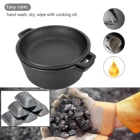
See price at Amazon See price at Aliexpress
4. Copper & Aluminum – Heat Fast, But…
Copper and aluminum heat up quickly. That’s great for fast cooking. But they can warp if overheated. They also don’t work on induction cooktops unless they have a stainless steel base. I once had an aluminum pan that bent on my electric stove—lesson learned! If you choose these, make sure they have a strong, flat bottom.
✅ Best for: Quick heating and lightweight cookware needs.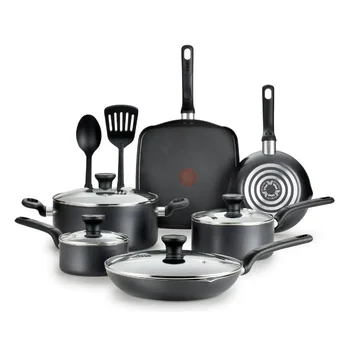
See price at Amazon See price at Aliexpress
5. Ceramic – A Non-Toxic Alternative
Ceramic cookware is non-toxic and chemical-free. It’s a solid choice if you want a healthier option. But it’s not as strong as stainless steel or cast iron. Over time, the coating wears off. If you go ceramic, pick a high-quality brand with multiple coating layers.
✅ Best for: Health-conscious cooks who want a chemical-free option.
See price at Amazon See price at Aliexpress
So, What’s the Best Cookware for an Electric Stove?
If you need one solid option, stainless steel is the best choice. It’s strong, even-heating, and works on all stoves. Nonstick is great for quick meals. Cast iron keeps heat longer than anything else. Ceramic and aluminum are good lightweight options with some trade-offs. Pick the one that best suits your culinary preferences!
Best Pots and Pans for Different Types of Electric Stoves
Not all electric stoves are the same. Some have coil burners, while others have smooth glass tops. And if you have an induction cooktop, that’s a whole different story! Picking the right pots and pans for your stove can save you a lot of frustration. Let’s break it down so you can cook with confidence.
Top Pots & Pans for Glass Top Electric Stoves
Glass top stoves look sleek, but they’re a bit picky. Since the surface is smooth and delicate, you need cookware that won’t scratch or wobble.
✔ Flat-bottomed pans work best – They make full contact with the stove, ensuring even heating. I learned this the hard way when my old, warped pan left my pancakes half-cooked on one side! ✔ Stainless steel is your best bet – It heats evenly, is durable, and won’t damage the glass. ✔ Avoid rough-bottomed cookware – Cast iron and stoneware can scratch the surface if dragged. ✔ Be mindful of weight – Heavy cookware can crack the glass if dropped. (Yep, I once chipped my stove with a cast iron skillet!)
💡 Best Pick: A stainless steel cookware set with an aluminum core for even heat distribution.
Best Pans for Electric Coil Stoves
Electric coil burners heat up slowly but hold heat well. The challenge? Uneven heating if the pan isn’t sturdy.
✔ Choose heavy-bottomed cookware – It helps distribute heat evenly, reducing hot spots. ✔ Cast iron works great – It holds heat like a champ and cooks food evenly. Just don’t slide it around too much to protect your burners. ✔ Nonstick pans work well too – Just pick high-quality ones that can handle medium to high heat. ✔ Warped pans are a no-go – They won’t sit flat on the coils, leading to poor heating.
💡 Best Pick: A thick stainless steel or cast iron skillet for steady, even heat.
Best Cookware for Induction Cooktops
Induction stoves are fancy—they heat using magnets! That means not all cookware will work. If a pan isn’t magnetic, it won’t heat up at all.
✔ Use magnetic cookware – Stainless steel and cast iron are perfect. ✔ Avoid aluminum and copper unless they have a magnetic base – Otherwise, they won’t work. ✔ Check for an induction-compatible symbol – Some cookware is labeled as “induction ready.” ✔ Flat-bottomed pans are a must – Just like glass tops, induction stoves need full contact for even heating.
💡 Best Pick: A stainless steel cookware set with an induction-compatible base.
Final Thoughts: Choose What Works for Your Stove
If you have a glass top stove, go for stainless steel with a smooth base. For coil burners, cast iron or thick stainless steel works best. And if you’re using induction, make sure your pans are magnetic.
The right pots and pans make cooking easier, more enjoyable, and safer for your stove. Pick wisely, and happy cooking!
Top Picks for Electric Stove Pots & Pans
Choosing the right pots and pans makes cooking easier and cleanup faster. I’ve tested many types, from stainless steel to nonstick. Some work better than others on electric stoves. Whether you have a glass top, coil burner, or induction cooktop, the right choice matters. Let’s look at the best ones.
The Best Electric Stove Nonstick Pots & Pans
Nonstick pans make cooking simple. Eggs don’t stick, pancakes flip easily, and cleaning is quick. But not all work well on electric stoves. You need a strong, heat-resistant coating.
✔ T-fal Ultimate Hard Anodized Nonstick Cookware – Scratch-resistant and heats evenly. Great for glass and coil stoves. It has a Thermo-Spot indicator that shows when it’s ready.
✔ Calphalon® Hard-Anodized Nonstick Cookware Set – Works on all electric stoves, even induction. Oven-safe up to 500°F. The stainless steel base prevents warping.
💡 Quick Tip: Use medium heat to keep nonstick pans in good shape.
The Best Pots and Pans Made of Stainless Steel for Electric Stoves
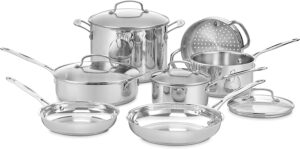
Stainless steel is durable and heats evenly. It doesn’t react with food and works on all stove types. Multi-ply construction is best.
✔ Cuisinart 11-Piece Cookware Set – Triple-ply design for better heat control. No hot spots. Dishwasher-safe.
✔ HexClad Hybrid Nonstick 6-Piece Pot Set – High-quality with great heat control. Works on all electric stoves, including induction.
💡 Quick Tip: Preheat for a minute before adding oil to stop food from sticking.
Best Affordable & Non-Toxic Options

Want safe and budget-friendly cookware? These are great picks.
✔ Astercook 21 Pcs Pots and Pans Set – Non-toxic, PFOA-free, and lightweight. A great ceramic option.
✔ Lodge Cast Iron Skillet – A classic. Works on induction and coil stoves. Be careful with glass tops.
💡 Quick Tip: If you have an induction cooktop, make sure your cookware is labeled as induction-safe.
Final Thoughts: Choose What Fits Your Cooking Style
The best pots and pans depend on how you cook. Stainless steel lasts long, nonstick is easy, and cast iron holds heat well. On a budget? Try ceramic or low-cost stainless steel. Good cookware makes cooking better!
🔍 Where to Buy: Find these on Amazon, Walmart, and kitchen stores. Want real feedback? Check Reddit discussions on cookware for electric stoves.
Ready to upgrade? Pick the best set and enjoy stress-free cooking!
Tips for Cooking on an Electric Stove
Cooking on an electric stove isn’t as straightforward as it seems. If you’re switching from gas, you might be in for a surprise—these stoves heat differently, cool down slower, and can be tricky to master. But don’t worry! I’ve learned a few tricks along the way that will make your cooking experience smoother and more enjoyable.
1. Preheat Your Pans (Patience Pays Off)
Electric stoves take longer to heat up than gas burners. Unlike an instant flame, the heating element gradually warms up, so preheating your pan is key to even cooking. I’ve made the mistake of rushing and tossing food into a lukewarm pan—big mistake! Instead, let your pan heat up for a couple of minutes before adding oil or ingredients.
Quick Tip: Place your hand a few inches above the pan—if you feel steady warmth, it’s ready to go!
2. Use Flat-Bottomed Cookware for Better Contact
Electric stoves distribute heat through direct contact. That means a warped or uneven pan won’t heat evenly, leading to hot spots (and burnt food in some areas). Stainless steel and heavy-bottomed cookware work best because they sit flat and spread heat evenly.
Quick Tip: If your pan wobbles on the stovetop, it’s time for a replacement.
3. Adjust the Heat Gradually (Avoid Burnt Dishes!)
One thing about electric stoves? They don’t cool down quickly. When you turn the knob down, the burner stays hot for a while. If you’re cooking something delicate—like eggs or sauces—move the pan off the burner to cool it down faster.
Quick Tip: If you need to simmer, turn the heat down early so the stove has time to adjust.
4. Clean Your Glass Top or Coil Burners Regularly
A dirty stovetop can mess with heat distribution. Glass top stoves need special care—spills can burn into the surface, making them harder to clean. For coil burners, food debris can build up and cause uneven heating.
Quick Tip: For glass tops, use a razor scraper and a non-abrasive cleaner to keep it spotless. For coil burners, lift them up and clean underneath!
5. Use the Right Cookware for Your Stove Type
- Glass top stoves need smooth-bottomed pans to prevent scratches.
- Coil burners work best with heavy-bottomed stainless steel or cast iron.
- Induction cooktops require magnetic cookware (test yours with a fridge magnet!).
Quick Tip: Stainless steel with an aluminum core is a great all-rounder for electric stoves.
6. Give Cast Iron Some Extra Care
Cast iron is fantastic for electric stoves, especially coil burners. But on a glass top? Be careful—it’s heavy and can scratch the surface. Always lift, never drag. Also, since cast iron holds heat well, use lower settings to avoid overheating.
Quick Tip: Place a paper towel under your cast iron pan on a glass top to reduce scratching.
7. Match the Burner Size to Your Pan
Ever noticed how some pots take forever to heat up? That’s because your burner is too small. For efficient heating, use a burner that closely matches the size of your pan. A small pot on a large burner wastes energy, while a large pan on a small burner won’t heat evenly.
Quick Tip: When in doubt, go one size up with the burner rather than too small.
8. Be Mindful of Residual Heat
Electric burners don’t cool instantly. If you’re done cooking, but your food needs to stay warm, turn off the burner early and let residual heat do the work. This trick works great for finishing dishes without overcooking them.
Quick Tip: Remove delicate foods (like eggs or fish) from the burner a minute before they’re fully cooked.
9. Don’t Slide Your Pans on a Glass Top
It’s tempting to shuffle your pan around, but glass top stoves scratch easily. Instead, lift and move your cookware gently. This small habit can save you from permanent marks on your stovetop.
Quick Tip: Use silicone mats or felt protectors when storing heavy cookware on a glass top.
10. Keep a Backup Heat Source (For Those Slow Warm-Ups)
Electric stoves don’t heat as fast as gas, so if you’re in a hurry, an electric kettle or microwave can help. Need boiling water quickly? Start it in the kettle and transfer it to your pot—it saves time!
Quick Tip: For fast searing, heat your pan on medium-high, then drop to medium to maintain a steady temperature.
Final Thoughts: Mastering Your Electric Stove
Cooking on an electric stove takes a little patience, but once you get the hang of it, it’s a breeze. Preheat your pans, use the right cookware, and take advantage of residual heat to avoid overcooking. Whether you have a glass top, coil burner, or induction stove, these small adjustments will make your cooking experience easier and more enjoyable.
Happy cooking! 🍳
FAQs: Best Pots and Pans for Electric Stove
- What type of pots and pans are best for an electric stove?
The best pots and pans for electric stoves have flat, heavy bottoms for even heat distribution. Stainless steel, nonstick, and cast iron cookware work well. - Do you need special pans for electric stoves?
Yes, electric stoves need flat-bottomed cookware to ensure proper heat contact. Stainless steel, aluminum, and nonstick pans are ideal choices. - What is the best cookware material for an electric stove?
Stainless steel, hard-anodized aluminum, and nonstick cookware work best on electric stoves. These materials distribute heat evenly and prevent hotspots. - Are stainless steel pans good for electric stoves?
Yes, stainless steel pans are great for electric stoves. They are durable, distribute heat evenly, and work well on coil and glass cooktops. - What are the best nonstick pots and pans for an electric stove?
The best nonstick cookware for electric stoves includes brands like T-fal, Calphalon, and GreenPan. Look for PFOA-free, scratch-resistant coatings. - Can you use cast iron on an electric stove?
Yes, cast iron works on electric stoves, but it heats slowly. Use enameled cast iron for better heat distribution and to prevent scratches on glass cooktops. - What are the best pots and pans for an electric glass top stove?
Flat-bottomed stainless steel, aluminum, and ceramic-coated cookware work best for glass top electric stoves. Avoid rough or warped bottoms. - What are the best pans for an electric coil stove?
For electric coil stoves, choose stainless steel, cast iron, or aluminum cookware with flat bases to ensure even heat transfer. - What are the best pots and pans for an electric stove on Amazon?
Top-rated cookware for electric stoves on Amazon includes T-fal, Cuisinart, and All-Clad. Check reviews for durability and even heating. - What is the best stainless steel cookware for an electric stove?
All-Clad, Cuisinart, and Calphalon stainless steel cookware sets are top choices. They heat evenly and resist warping over time. - What are the best affordable pots and pans for an electric stove?
Budget-friendly options include T-fal, Utopia Kitchen, and GreenLife. These provide excellent performance without going over budget. - What is the best cookware for electric stoves on Reddit?
Reddit users recommend All-Clad, Cuisinart, and Lodge cast iron for electric stoves. Nonstick and ceramic brands like GreenPan are also popular. - What are the best non-toxic pots and pans for an electric stove?
Look for PFOA-free, ceramic, or stainless steel cookware. GreenPan, Caraway, and Made In offer non-toxic options. - What is the best cookware set for an electric stove?
Top cookware sets for electric stoves include the All-Clad D3, T-fal Ultimate Hard-Anodized, and Cuisinart Multiclad Pro. - What pans should I avoid on an electric stove?
Avoid warped, thin, or rough-bottomed pans. Copper and glass cookware without a flat base may not heat evenly on electric stoves.
Conclusion
Let me tell you what I know about pots and pans. I’ve tried them all on my electric stove. You don’t need to make it hard. I found that steel pans work best. Non-stick pans are good too. So is cast iron. Just pick what works with your stove type.
Here’s the truth – you don’t need to spend lots of money. What counts is how well your pans heat up food. How long they last matters too. Get a good steel pan first. Add a non-stick pan for eggs. Maybe get a cast iron pan for meat.
I used to think any pan would work fine. Boy, was I wrong! The right pans changed how I cook. My food cooks better now. Clean-up is quick. My pans last longer too. Good pans help if you’re new to cooking. They help if you cook a lot too.
Want new pans? Take it slow. You don’t need to buy them all at once. Pick one good pan that fits how you cook. Think about what stove you have too. You’ll be glad you took your time to choose well.
The best pans are the ones that work for you. Keep it easy. Buy good pans, not lots of pans. Have fun picking your set. I love helping others find what works for them. It makes me happy when they love cooking more. Good luck in your kitchen! 🍳
To Know more about The Best Inexpensive Knife Set – Now At A Sensational Price!, please visit our Kitchen Gadget.
External links for more informations

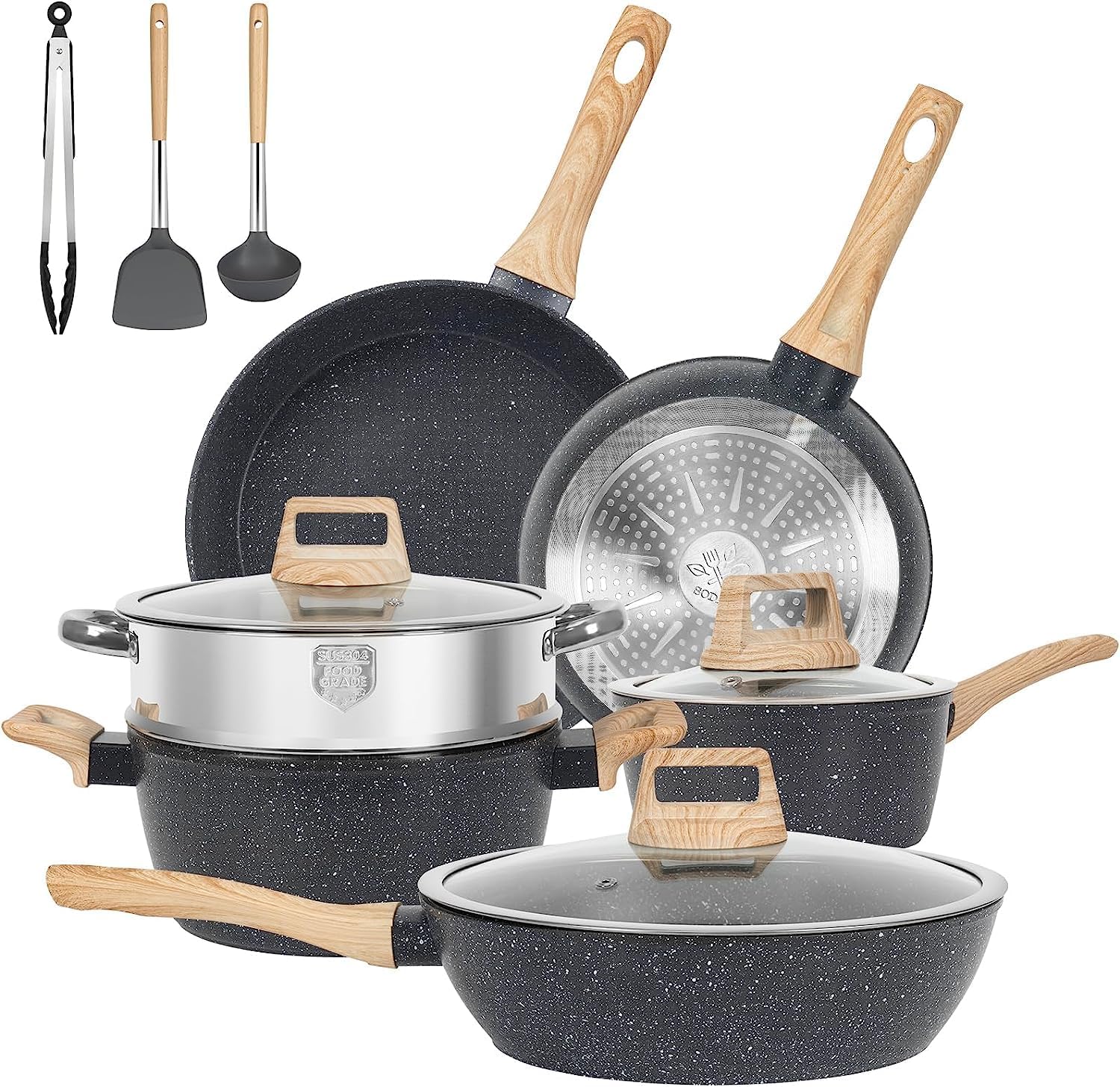
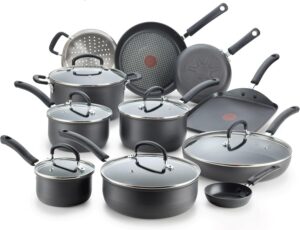
1 thought on “Amazing Best Pots and Pans for Electric Stove 2025”